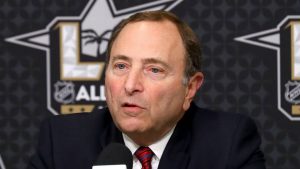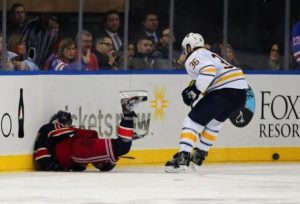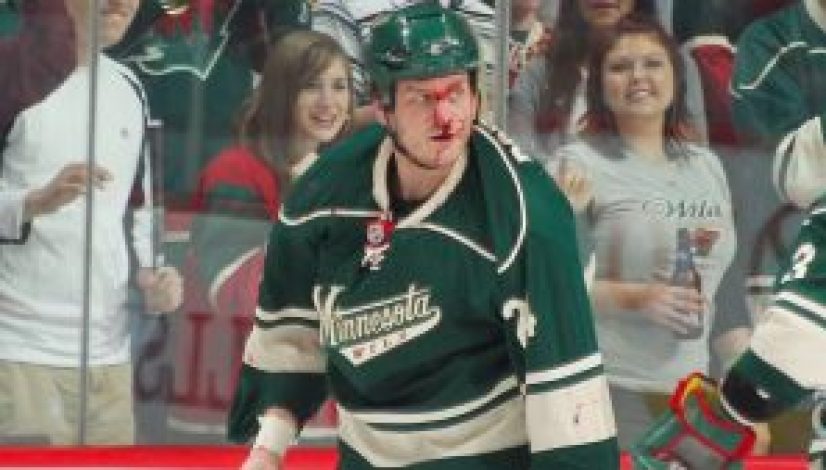What Is the NHL’s Drug Policy for Marijuana?
In the United States the NHL ranks 4th or even 5th when it comes to major sports depending on which poll you look at. The NFL sits at the top followed by the NBA, Major League Baseball, then the NHL or Soccer, again depending on the poll. One of the major differences between the NHL and the other major US professional sports leagues is the number of teams in the league located in Canada. Other leagues such as the NBA (the Toronto Raptors) and MLB (the Toronto Blue Jays) have a team in Canada, but the NHL has seven including the Winnipeg Jets, which I had no idea was a team until I began to look into this article.
 Derek Boogaard
Derek Boogaard
Of the major sports leagues the NHL has one of the more relaxed policies regarding marijuana compared to the other leagues. This in part could be related to the number of teams found in Canada. Canada has had a comparatively more relaxed drug policy as a country than that of the United of States. Canada treats drug addiction and abuse in a much different manner than the United States. Canada treats issues with drugs more as a health care issue, and while until recently marijuana possession and distribution were illegal, the criminal justice system in Canada was much less punitive for Canadian offenders than their counterparts in the United States.
The NHL overall drug policy is unique in that the league essentially has two drug policies. The first is the performance enhancing drug policy. This policy focuses on banning drugs such as anabolic agents, stimulants, growth hormones, and drugs that are considered to give players an advantage on the field of play, or in the case of the NHL, on the ice. This list is based off of the standards set by the World Anti Doping Agency, or WADA, and it’s interesting that the NHL and NHLPA expressly state that the two entities reserve the right to add or remove substances from the list as they see fit. That last statement is critically important because most forms of cannabis and THC are on the WADA banned substance list. What the NHL has effectively done is used WADA restrictions as a base but drawn a definitive line between performance enhancing drugs and drugs of abuse. For PED use the league has 20 and 60 game bans, including fines and monitoring programs but rugs of abuse are treated differently.
Back in 1996 the NHL created the Substance Abuse and Behavioral Health program or SABH for short. This program was designed for the specific purpose of dealing with issues of substance abuse for players and their families in a confidential manner. The SABH provides a road map for players dealing with addiction, but also allows the program to monitor drug use and make a judgement call on whether or not to intervene with treatment, or by simply having a meeting with a player allowing them to explain the situation. It works by using the players samples from the PED tests and reporting anonymous results of drugs of abuse found in the players’ samples. If a sample is deemed to have a dangerously high amount of an illegal substance, the player is contacted and a determination is made for treatment. While repeated revelations of dangerous levels of any particular drug can eventually lead to a suspension or permanent ban, the response from the league is typically not punitive. The SABH is designed to help the players deal and work through the issues, and not punish and isolate them from the support of the league, which is the complete opposite of how the NFL approaches its drug policy.
 Gary Bettman
Gary Bettman
What is also interesting about the NHL’s substance abuse policy is that the list of banned substances is not clearly defined or expressed in the program document itself. I can only assume that the players are provided a confidential list of both banned PED’s and drugs of abuse for their own knowledge, but the league does not want that list made public for one reason or another. What we do know about the lists being kept confidential is that this allows both the NHL and NHLPA to use their own discretion on how they handle drug related issues in the league. Using the NFL as an example, by not only publicizing what is banned, and the exact punishments at each level, there leaves no room for discretion. Some may view this kind of openness as a required level of objectivity which helps prevent discrimination or unfair treatment, but it also leaves little room for special cases due to public scrutiny.
Because the NHL allows for discretion in determining high levels of drugs in a player’s system, player use of cannabis to help deal with various health issues becomes a much easier road to navigate in the NHL than in other leagues. Players in the NHL take similar abuse to their bodies as NFL players. There are collisions at high rates of speed, broken bones, lost teeth, and concussions. Aside from the abuse of the game, players are human and have issues with anxiety and other social issues that many people believe medical marijuana can help manage.
Players in the NHL have an opportunity not afforded to players in other leagues because they can manage their pain in other ways besides the typical prescription drugs and opioids used in other leagues. If a player in the NHL is worried about the side effects of Toradol, or the possibility of addiction to Oxycontin, they can opt to manage pain using marijuana and not have concerns of losing a percentage of their season or their game checks because of it. While the NBA has a somewhat more liberal view than the NFL regarding marijuana, there is still a punitive aspect to their drug policy that can be costly to a player in terms of time and money. An NHL player is free of those concerns on most levels depending on how the league views the amount of THC found in players’ systems and what the league has determined the threshold for “dangerously high levels” of THC to be.
The NHL has seemingly found the nexus between player safety, monitoring for illicit drug use, and not condoning illegal drug use. The other leagues repeatedly reference that marijuana is illegal on the federal level and they need additional research before they allow players to use cannabis. If cannabis is proven to have medical benefits (in their opinion), they would want to regulate the use. From the beginning, the NHL has provided an avenue for players to use their own discretion when it comes to taking care of their own bodies and how they spend their free time. While marijuana is illegal in the United States on the federal level, laws do not require that employers take specific actions if an employee is found to be using the drug. The other sports leagues choose to use federal law as a cover, along with a lack of clinical trials. In reality, the other leagues could model their drug policies after that of the NHL with little or no repercussions from the federal government.
 There are players in all of the different leagues using marijuana for some reason. Not all players are using marijuana, but each league has documentation of players using marijuana in some shape or form. Instead of putting their players in the news and affecting their pay checks, other leagues could follow the example of the NHL and put the choice in the hands of the players. The leagues could be there as a mechanism for support and guidance and not the arbiters of right and wrong.
There are players in all of the different leagues using marijuana for some reason. Not all players are using marijuana, but each league has documentation of players using marijuana in some shape or form. Instead of putting their players in the news and affecting their pay checks, other leagues could follow the example of the NHL and put the choice in the hands of the players. The leagues could be there as a mechanism for support and guidance and not the arbiters of right and wrong.
Facebook Comments
Tags
canada legalizationcannabisNHLNHL banned substance list


